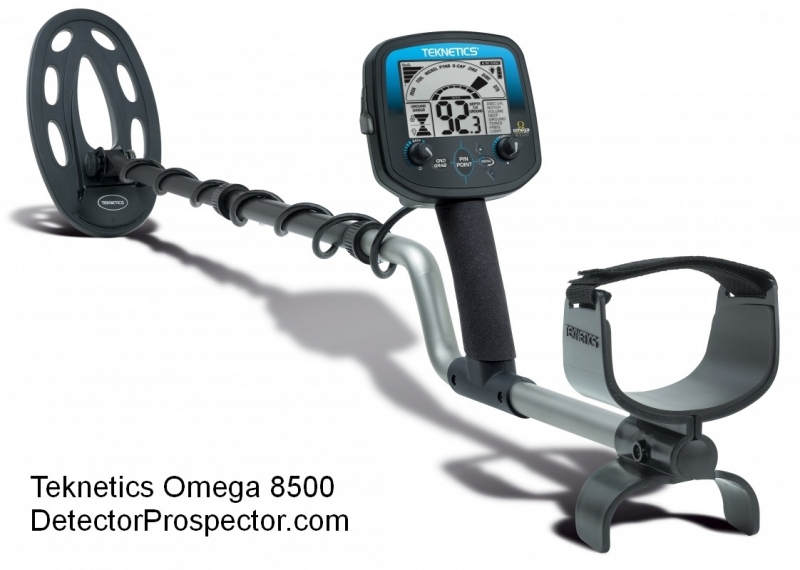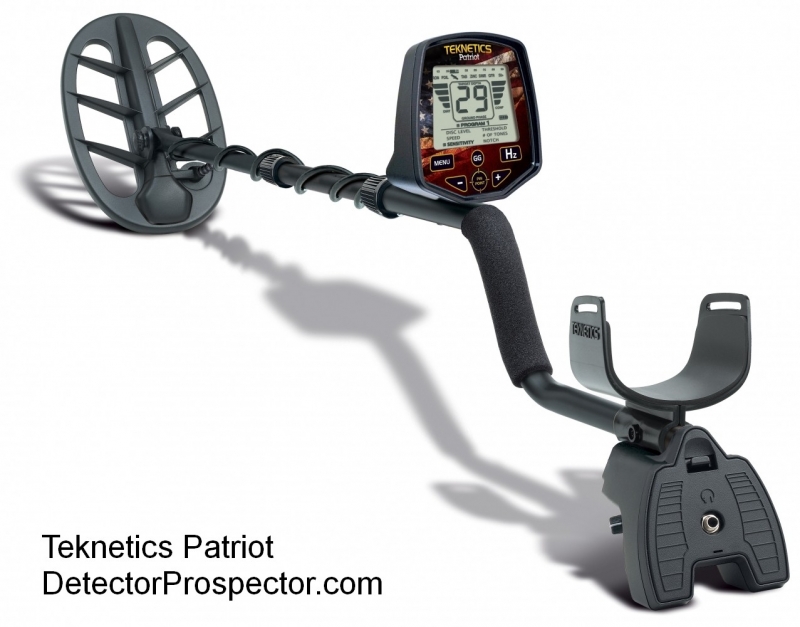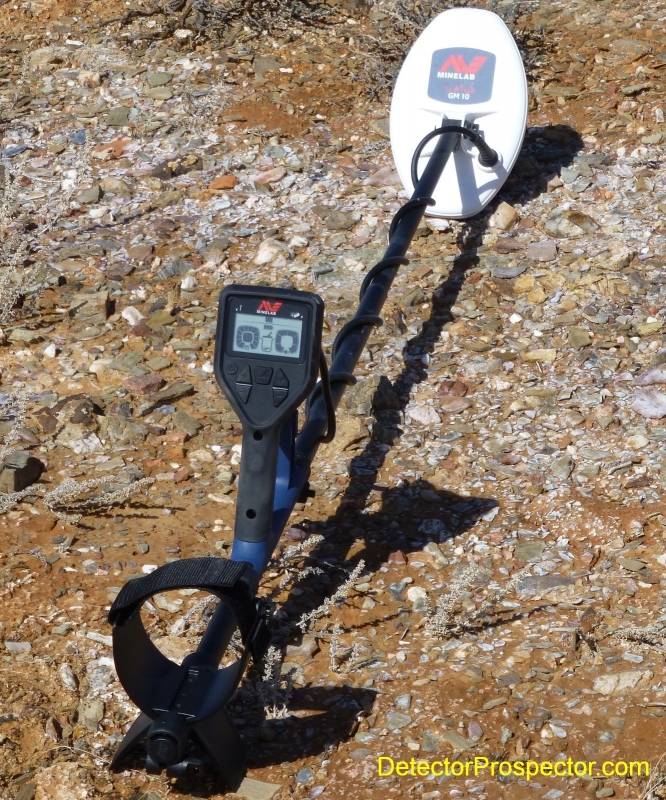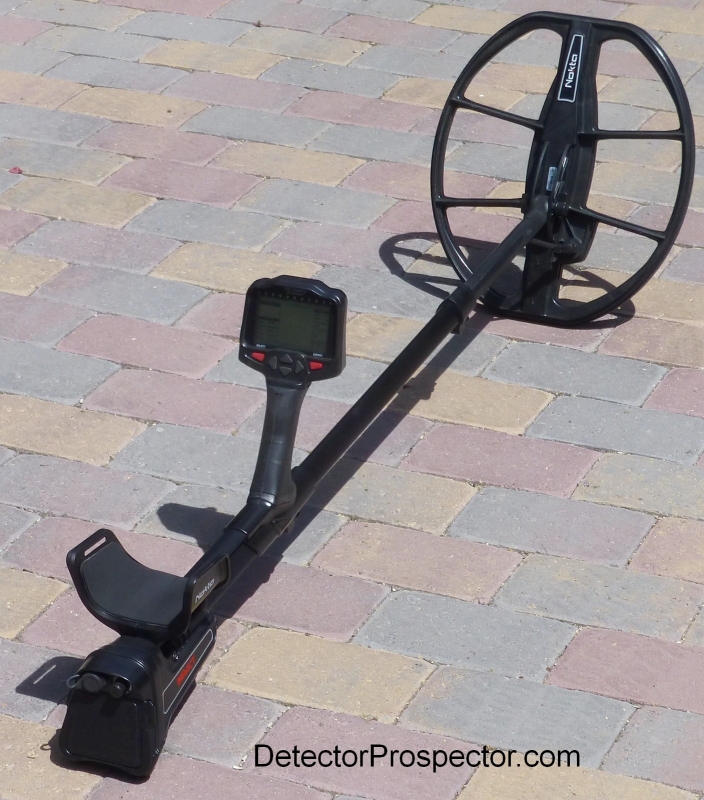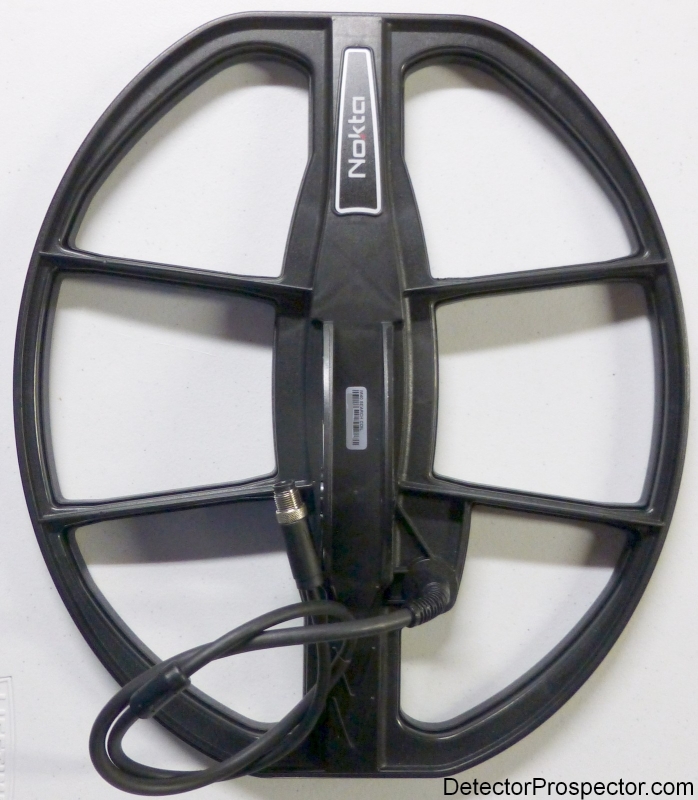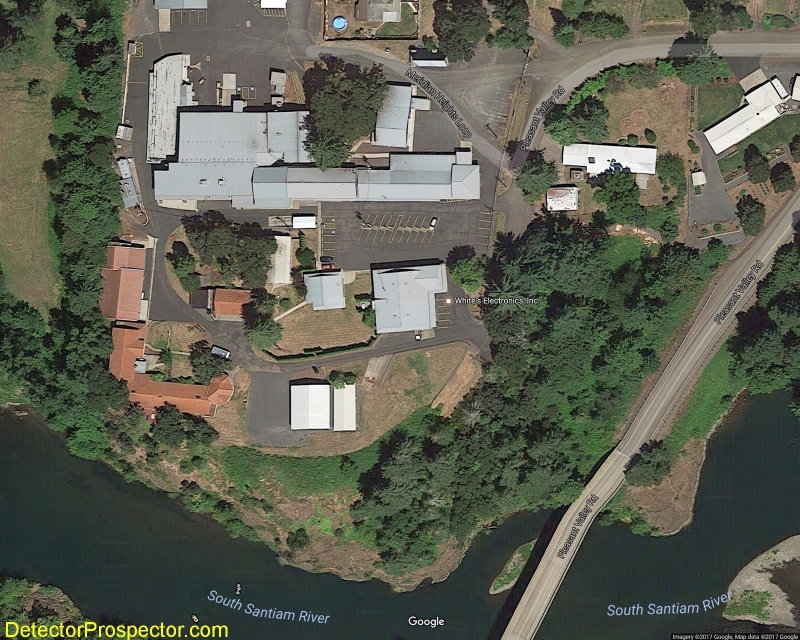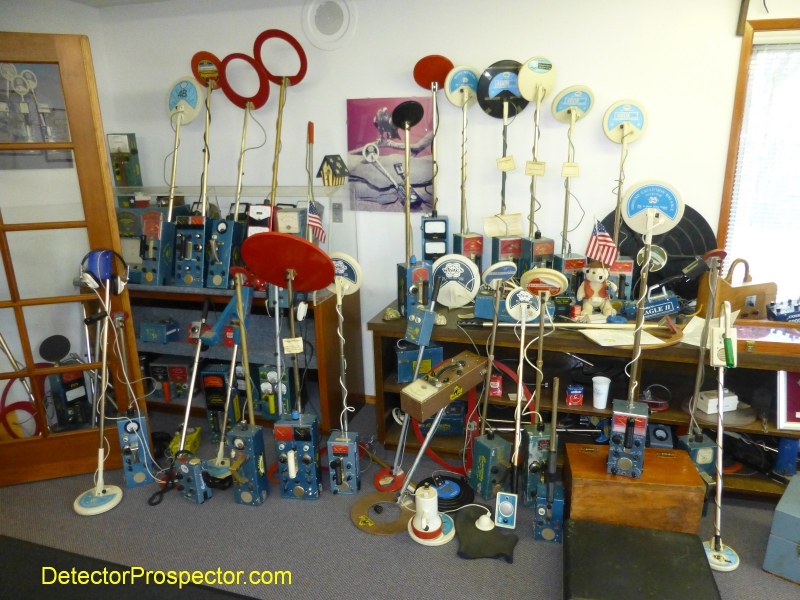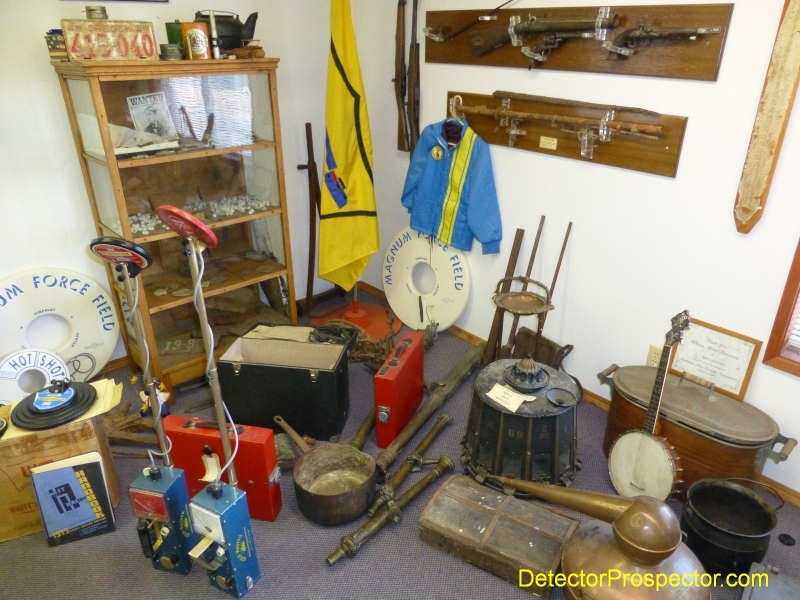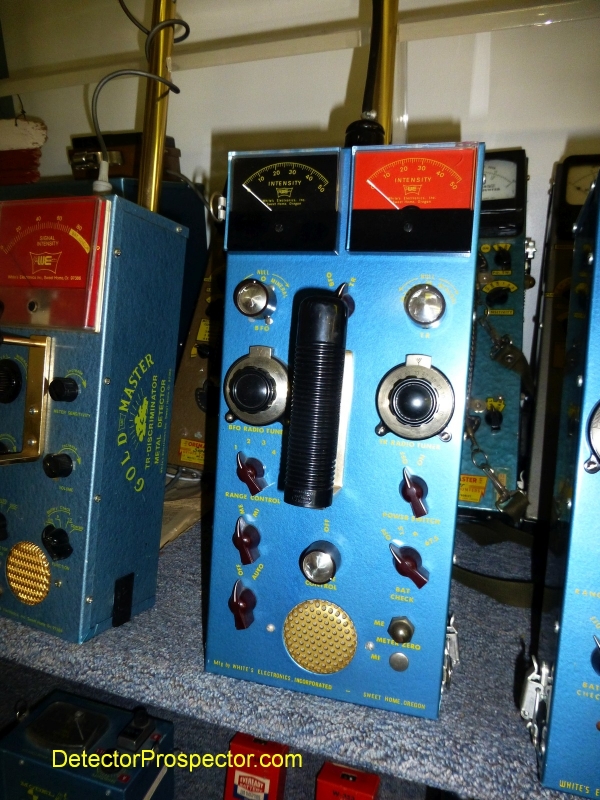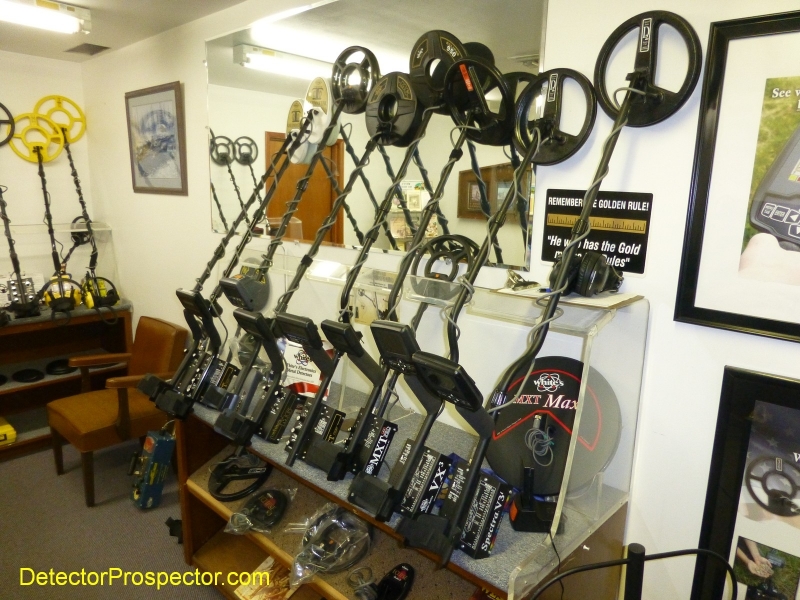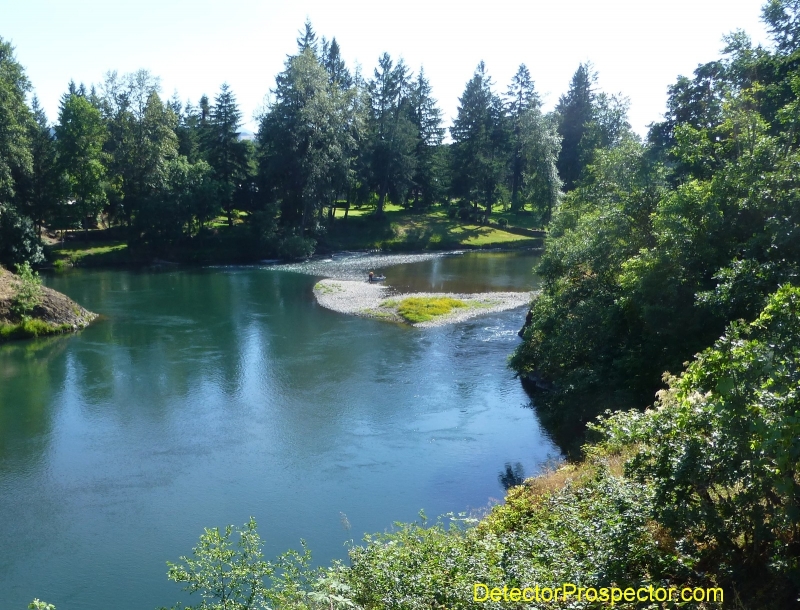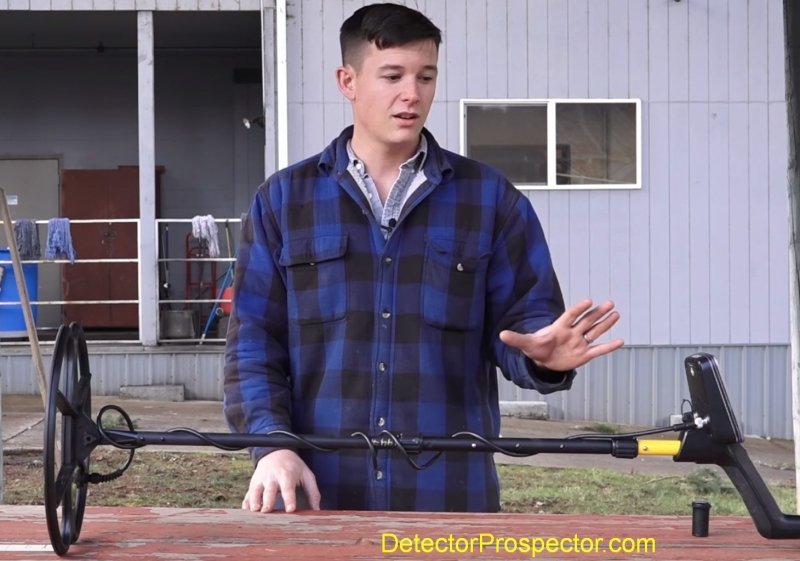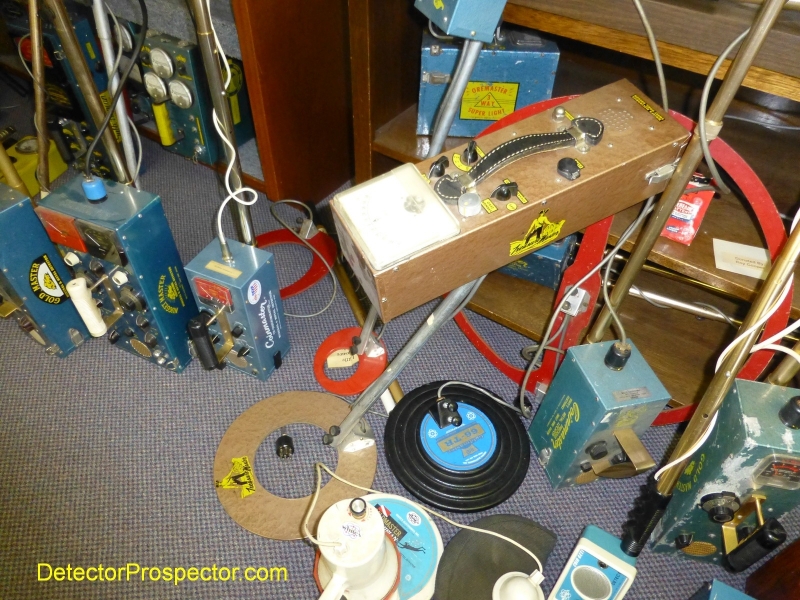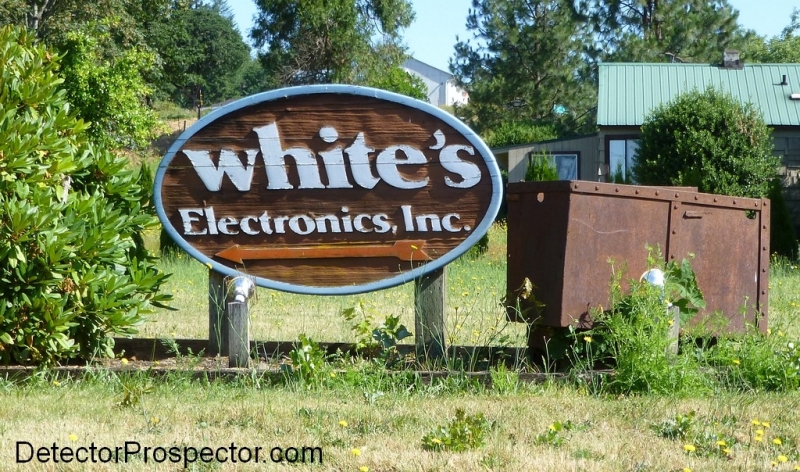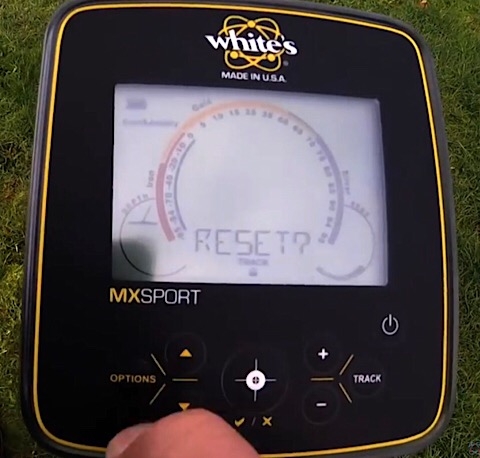-
Posts
19,756 -
Joined
Content Type
Forums
Detector Prospector Home
Detector Database
Downloads
Everything posted by Steve Herschbach
-
Well, that about sums it up. There is a lot more to a detector than frequency. Frequency sets some basic parameters, but the sensitivity of the receiver circuit (how high gain is it?), transmit power, and the efficiency of the ground balance and discrimination filtering methods employed are every bit as important. Even such basic items as what type of coil is stock with the detector matter a lot, as does the visual display/control layout and audio characteristics. I pay attention to frequency but it is only one factor among many when choosing a detector. In general, single digits (1 - 9 khz) are coin detectors, and models in the teens (10 - 19 khz) are multi use. The 7.7 khz Omega 8500 comes stock with a concentric coil and is designed as a coin detector and the Patriot at 13 khz with a DD coil is a more general purpose unit. Both however will probably find most of the items that the other will. In the end you have to just look at the features and make a choice. If all you ever do is coin hunt the Omega 8500 is a fine choice. I have to admit to being a bit biased to concentric coils myself when it comes to dealing with bottle caps. Running with wide open tones is usually the solution to your ferrous wrap problem. Many ferrous items generate both ferrous and non-ferrous responses, and when you suppress the ferrous response via discrimination you make the item appear non-ferrous. Running with full tones allows you to hear both components of the target signal. The Teknetics Patriot at 13 kHz and with the DD coil is going to handle tougher ground conditions better. Adjustable Backlight Waterproof Elliptical Searchcoil Notching Controls – Discrimination & Variable Volume by Category Independent Gain & Threshold Control Ground Mineralization Readout Ground Phase Error Readout 2 Modes of Operation: Discrimination All Metal Selectable V.C.O. Base Tone Choice of 3 Tones plus V.C.O Digital Target-ID System Ground Grab® Computerized Ground Balancing with Manual Override Frequency Shift to Eliminate Electromagnetic Interference (EMI) Visual Background Iron-ID Enhanced Multi-Level Depth Boost Static Pinpoint with Numerical Depth Indicator Large Target Overload Alarm Quick-Switch Mode Control – Discrimination to All Metal Mode Multiple Audio Tone ID Options Expanded Iron ID Range, 1-39 Unique, Intuitive Interface & Display Standard Coil 10” (25 cm) Concentric Open Frame Waterproof Coil Yes Batteries 9-Volt Alkaline (not included) Battery Indicator Yes Battery Life Yes Pinpoint Mode Yes Target ID 1-99 Target-ID Numbers Audio 3-Tone plus V.C.O Volume Control Yes 0-10 Discrimination Modes 8 Categories + Notch Discrimination Adjustment 1 - 65 Sensitivity Adjustable 1 - 99 Operating Frequency 7.69 kHz Depth Indicator Digital, 1" increments Weight 2.5 lbs. (1.1 kg) Length 43” - 53” Headphone Jack Yes, ¼” (6.3 mm) Ground Balance Ground Grab® Computerized Ground Balancing Backlight Yes More information on Omega 8500 13 kHz frequency – good for coin shooting, relic hunting and gold prospecting Frequency shift for eliminating electrical interference Visual Target-ID by category and 0-99 numerical indication Target-ID confidence bar Continuous ground mineral concentration readout Push-button static pinpoint Speed selection – normal for most conditions, slow for deep coins in non-trashy areas 11-inch waterproof DD searchcoil 40 hours of battery life (4 AA batteries) Standard Coil 11-inch Open Frame Bi-Axial™ Waterproof Coil Yes Batteries 4x AA (not included) Battery Indicator Yes Battery Life 20-25 hrs. Pinpoint Mode Yes Target ID Yes Audio 8 audio tone options Volume Control Yes Discrimination Adjustment Yes Sensitivity Adjustable Operating Frequency 13 kHz Depth Indicator Yes, 4-segment Weight 2.9lbs (1.3 kg) Length Length 43.5” to 52.5” (110 cm to 133 cm) Headphone Jack Yes Ground Balance Yes Backlight No More information on Patriot
-

Nokta Impact And New 15"x14" Im40 Coil
Steve Herschbach replied to Steve Herschbach's topic in Nokta / Makro Metal Detectors
I will be curious what you have to report Danial. Your observations on detector performance in bad ground often mirror my own, with me doing to gold thing and you doing the relic thing. -

Minelab Gold Monster 1000 Begins Delivery
Steve Herschbach posted a topic in Minelab Metal Detectors
I see customer deliveries have begun in Australia so the U.S. should be any time now. Minelab Gold Monster 1000 Threads -

White's Electronics Visit And A New V3i
Steve Herschbach replied to Steve Herschbach's topic in White's Metal Detectors
I thought the same thing and was Googling for part number changes yesterday but could find none. The scuff cover I ordered was large and a bad fit so I do think the D2 was slimmed down. I will weigh mine and post. More investigation needed. -

White's Electronics Visit And A New V3i
Steve Herschbach replied to Steve Herschbach's topic in White's Metal Detectors
Posts are needed in the Coin, Jewelry, Meteorite and other forums so thank you for your efforts David, and your kind words. -

XP Deus HF Outing 4 Cancelled
Steve Herschbach replied to Condor's topic in Detector Prospector Forum
I'm not going to like that post because that just plain sucks. I am glad the damage was not any worse though it is certainly bad enough. I hope you heal up well and soon! -
So far I have always leaned towards specialty machines. However, as the technology improves I am sure we will see more advancement made towards perfecting true multi purpose detectors. In the end all we can do is go use them and decide what works best for each of us. Some people need a dozen detectors, but we are certainly closer to the day where one good detector is all most people need. I don't see much difficulty in sorting it out however. Regardless of components used they either perform or they do not. The only way I know how to do that is go use them personally.
-
I have been laying fairly low with the Nokta Impact so far. Part of that is I have been busy on other things. The main reason however is I quickly zeroed in on how I think the Impact will best serve me as a detectorist. In general I think I can speak for most people when I say we all like lighter weight detectors. However, one area where lighter is not better is when you use large coils. Balance is every bit as important as weight as it determines the amount of torque applied to your wrist as you swing the detector. A large coil on a very light detector creates a very nose heavy detector, one that will put more strain on you when you detect than a heavier but better balanced detector. It just so happens that the Impact with the rear mounted battery power/speaker module is a good design for a large coil from an ergonomics standpoint. This is especially true when in my experience Nokta has designed large coils that are quite light for their size. I was probably one of the first people that really zeroed in on the new IM40 15" x 14" DD coil when it was proposed for the Impact by Nokta. I got on an early wait list for the coil, and just received mine. Nokta Impact IM40 15.5" x 13.75" coil with scuff cover The IM40 DD coil measures 15.5" x 13.75" and comes with a fitted skid plate/scuff cover. The coil weighs 1 lb 13.0 oz or 822 grams as pictured with skid plate and cable and weighed on my postal scales. Yes, I had to say that as some people exclude cable weights from coils! For comparison the stock 11" x 7" IMP29 coil weighs 15.7 oz or 446 grams. I like the flat blunted ends on the IM40, which does help the Impact stay upright as the trailing edge of the coil acts as a flat bearing surface when the detector is at rest on the ground. I am not usually a fan of larger coils and in fact tend to lean to smaller coils for a lot of my urban metal detecting. Large coils "see" more area which can work against them in highly mineralized ground or in areas with lots of closely spaced trash. However, large coils even if they do not get more depth in highly mineralized ground can cover more area faster, and often ground coverage is every bit as important if not more so than depth. In medium to lower mineral ground a large coil can also offer that magic thing all detectorists crave - more depth! The Nokta Impact has another trick up its sleeve that favors large coils; the ability to change operating frequency on the fly. High frequencies offer more sensitivity to small items and quicker separation in dense trash as well as extended battery operating time. The main issue with higher frequencies is they also "light up" highly mineralized ground and hot rocks more so than lower frequencies. This can work against machines that are locked into higher frequencies when attempting to employ large coils in highly mineralized ground. Lower frequencies give up some of the high frequency "hots" on small targets but also are less sensitive to ground issues, including salt mineralization. The ability of the Nokta Impact to run at 20 kHz, 14 kHz, or even 5 kHz makes it very well suited for running very large coils. This is accentuated by the plethora of all metal modes available on the Nokta Impact which can deliver extreme performance when coupled with a large coil. The bottom line is I think the Nokta Impact and IM40 coil may be one of the very best options available for a person wanting to run a large coil on a VLF detector, with depths in all metal modes and milder ground that will challenge many PI detectors. For a lot of what I personally do, like gold prospecting or beach detecting, I will first attempt high frequency, high gain operation and then back off as ground or EMI conditions require. One thing it is important to know when running the Impact with large coils is how the Gain control works. If the Impact is running at Gain levels that are too high, the OVERLOAD message will appear on the screen. Note: You can increase or decrease the overload volume with the on/off button. When the volume of the device is at maximum, the overload volume will be low. As the volume of the device is lowered, the overload volume will increase. The electronic Gain has at least three distinct levels. There are distinct boosts between settings of 39 and 40 plus again between 69 and 70. Setting over 90 are a sort of hyper-Gain region only obtainable in low mineral/low EMI environments. Therefore I may attempt to start out in 20 kHz and a very high Gain. If overloading occurs I will lower the Gain for smooth operation, paying particular attention when I get down to 69. From there on down I need more field time, but at some point it will be better to drop to a lower frequency than to continue to lower the Gain setting. So in theory if at a setting of Gain 39 I still have issues at 20 kHz, it is time to go to 14 khz and run the Gain back up high. If conditions are still not amenable to running at 14 kHz and high Gain settings, I would then drop to 5 kHz and again attempt to run higher Gain levels. Note: people hunting larger, higher conductive items like silver coins and brass relics may very well just start out at 5 kHz. My focus is usually on lower conductive, smaller items i.e. gold. I so far have only done a small amount of detecting in a local park. I first tried Di3 and while it was working well enough the trash density was high and interpreting signals with a large DD coil can be challenging, especially when the coil generates multiple signals on very shallow items. I finally went to the unique GEN(D) mode and it was night and day. The GEN(D) all metal mode combined with the VCO effect makes sizing targets and identifying shallow targets a breeze, even in a trashy park situation. Shallow ferrous is easily identified also using GEN(D). There are several all metal modes a person can employ on the Impact as well as the extended range ground balance available in the COG (COnductive Ground). While the Impact performs ground balance in the range of 20-90 automatically in the other discrimination modes, it ground balances in the range of 0-90 in the COG mode. This enables easier ground balancing on conductive grounds where normally ground balance cannot be performed at all or performed with difficulty, such as salt water beaches. Remember that ground balancing to salt conditions always comes at the cost of reduced sensitivity to small gold items. There is more I could mention about this subject but I really need time to get the hours on the Impact running the large coil to get more into specifics about how to get the best performance out of it. Large coil VLF hunting is not for everyone and is not a magic bullet in any case, but it does offer possibilities for the more adventuresome detectorist. I will close with a picture of my Nokta Impact with new IM40 coil. The detector with this coil is only slightly nose heavy (keep the rod as short as possible) and weighs with batteries 5 lbs 2.0 oz (5.13 lbs) or 2322 grams.
-

White's Electronics Visit And A New V3i
Steve Herschbach replied to Steve Herschbach's topic in White's Metal Detectors
As always it just depends where you are. I have found the V3i to do well in highly mineralized ground like I have around Reno. Soil with lots of magnetite tends to compress the range of results obtained by all detectors by about 50%, making the differences seen in the field considerably different than experienced in other regions. White's being in Sweet Home, Oregon tends to build for this type mineralization, as it is what they have right out their front door. Same story though - you just have to find what works best for you in your soil on your targets. I admit I got the V3i again less for the performance and more for the whiz bang custom feature list. -
I am going through one of those periods where I load up a bit on new detectors and let it all sort out. Darwin's Survival Of The Fittest Detectors! This winter a number will not survive and will be looking for new home. This is the only way I have found that works for me. Detectors that serve a good purpose for me get used, others end up sitting. If they sit long enough, they are no longer needed. I have my nugget detecting fairly well sorted out. The GPZ 7000 gets used 90% of the time. I might pull out a VLF for a really trashy place, or for where the gold is smaller than the GPZ can hit (really small!). I do keep a Garrett ATX around to handle salt ground or oddball hot rocks the GPZ has trouble with but those situations have proven quite rare so far. So the GPZ is an obvious keeper. The ATX does double duty as my favorite water hunting machine so there is another. In the land of VLF however it is more complicated. I have this idea that a good selectable frequency detector might really do the trick in replacing two or more other models. The key there however is what I am going to go ahead and call "frequency spread" for lack of a better term. What do I mean by frequency spread? Simply put, the number of kHz between the lowest and highest frequency the detector can operate at. The lowest frequency is basically the "large item" frequency that more easily handles bad ground, and the high frequency is the "small item" frequency that tends to have more issues with mineralized ground or hot rocks. The high frequency option is critical for a person like me who nugget hunts. To really be able to replace machines like the 45 kHz Minelab Gold Monster 1000, 48 kHz White's GMT, 56 kHz Makro Gold Racer, or 71 kHz Fisher Gold Bug 2, the highest frequency option of the detector needs to be 30 kHz or higher or as close to that as is possible. Low frequencies in the single digits are great for coin hunting or very large gold nuggets in bad ground. Frequencies in the teens are a great compromise. Some examples: Nokta Impact 5 kHz, 14 kHz, and 20 kHz (15 kHz lowest to highest) XP DEUS Low Frequency Coil 4 kHz, 8 kHz, 12 kHz, and 18 kHz (14 kHz lowest to highest) Rutus Alter 4.4 kHz to 18 kHz in 0.2 kHz steps (13.6 kHz lowest to highest) White's V3i 2.5 kHz, 7.5 kHz, 22.5 kHz (20 kHz lowest to highest - bonus - runs in multifrequency mode) I am still waiting on the XP DEUS High Frequency Elliptical Coil 14 kHz, 30 kHz, and 81 kHz (67 khz lowest to highest). The XP HF 9" round running at 14 kHz, 30 khz, and 59 khz (45 kHz lowest to highest) is currently available. In theory the White's V3i is a real winner here but I have just never really taken to the V3i as a prospecting detector. I have to be honest and say that so far the Impact floats my boat more in that regard due to its more traditional approach to a detector interface, all metal modes, and ground balancing. The problem with all of them though is they just don't reach high enough to be used both as coin and jewelry machines and yet still be capable of retiring the high frequency nugget detectors. And that is why I am still patiently waiting for that XP Deus V4 high frequency elliptical coil. At 81 kHz (or 59 kHz in 9" round version) the Deus HF coils on paper at least could in theory make the high frequency nugget detectors redundant. I have to admit I still have doubts however. So far dedicated specifically tuned single frequency detectors have always won the day. For a lot of people however, a selectable frequency machine might prove to be "good enough". The downside with the Deus is that to get the deeper seeking lower frequency large coil option you have to wrap up quite a bit of money into two coils. The 9.5" elliptical is just not going to reach real deep due to its small size. I have the 11" round low frequency coil which can run as low as 4 kHz, so together the two coils make a pretty formidable package. The other machines however can run both much smaller and much larger coils, and at considerably less cost than what DEUS coils cost due to each one being a self contained metal detector. It may be that the XP HF 9" round running at 14 kHz, 30 khz, and 59 khz (45 kHz lowest to highest) is the better compromise option for most people than the 5.5" x 9.5" elliptical. The Impact does suit me as far as the way it functions and I like the excellent inexpensive coil selection. It is a shame it weighs twice as much as the DEUS, but that may actually be a benefit when it comes to balancing large coils. Overall at the moment I am really liking the Impact - I just wish the frequency had topped out higher. I really wanted more like 5 - 15 - 30 kHz. Going from 14 kHz to 20 kHz is not quite providing the extra "pop" on tiny gold I would like to see.
-
Back in 2014 I got a smoking deal on a like new used White's V3i with over a year of remaining warranty. It was my third after the original Vision and then later a V3i. I quickly found a platinum ring that almost paid for what I had into it, but unfortunately I got busy on other things and when the warranty was about up I sold it. Well, I have regretted it ever since. The V3i is a unique detector that represents the end result of a design philosophy that I do not think we will see exceeded. You have programmable access to nearly every function that exists in a metal detector along with amazing control over the audio and visual interface. The bright, sharp, colorful screen has never been done better on any other model in the ensuing years. Owning the V3i is very much like owning a "design your own detector kit". I am very much not a person to have nostalgic feelings about metal detectors or to ever hang on to any very long. However, the V3i is in a class of its own in many ways and I decided if there was ever a detector I should just buy and keep it is the V3i. That being the case I decided to get a brand new one from the factory. I may very well end up using this detector to shoot a series of instructional videos about general metal detecting theory and technique. The functions and colorful screen can be used to well illustrate almost anything I can think of when it comes to metal detectors and how they work. Don't be holding your breath however - me getting around to doing some things like finishing the ATX Strip and Rebuild can sometimes take years! I finally had reason to drive west to visit family recently, and made a swing by White's a part of that drive. I contacted forum member Tom Boykin (tboykin) who works at White's to set up a good time for a meet and greet. And so it was I found myself heading for Sweet Home, Oregon! Click on photos for larger versions. Aerial view of White's facility.... White's sits across a bridge from the main of Sweet Home right on the banks for the beautiful South Santiam River.... Cross over the bridge and turn left and there is the sign... First thing you see entering the main office building is a little detector showroom... but the main attraction is a large display of old White's detectors and items found with them.... Here is the old BFO Nugget Master with dual meters. Ken White Sr. loved huge boxes, lots of knobs, and big or even multiple meters - I doubt ergonomic was even in his vocabulary! The big boxes were often empty with a little circuit board tucked in a corner. Next to the Nugget Master is an original type blue box Gold Master, part of the old T/R series. These are just collectors items folks so don't be tempted to buy one thinking you are getting a decent nugget detector - only the black box versions can be considered as modern detectors. The old blue box versions don't even ground balance. And a real sweetie, the Treasure Master! Anyway, I was running a tight schedule, arriving at Sweet Home at 11AM and heading on to Reno around 2:30 getting home near midnight. Tom was gracious enough to give me a tour of the facilities where I met faces both new and old, and he bought lunch to top it all off. Then I picked up my brand new V3i (which I really am going to keep) and hit the road for Reno. Tom is an engaging young man with infectious enthusiasm and we are lucky to have him on the forum. He is still relatively new to detecting so go easy on him. The fact is though it will be people like Tom that take metal detecting to the next generation. Thanks for the tour Tom! For those who have not been so lucky check out the White's Electronics Factory Tour Video. And finally, here is my new baby still waiting to make its first find...
-
Very good post by Mike Hillis at Dankowski's on V3i filtering options and how they affect performance. Older designs often refer to having "two filter" or "four filter" methods. Here is a post by Monte that discusses that subject. See also "Ground Filtering" in the DFX Engineering Report by Mark Rowan.
-
Welcome to the forum! As an isolated incident I would not think much of it. Could have been a glitch that the reset eliminated. Could have been a temporary EMI issue. Regardless it sounds like the machine is running fine now. If it was me I would not put further thought into it unless it occurs again. Modern detectors that operate via a program in firmware deal with innumerable variables that can interact to cause a problem. It is actually something to expect at some point, and is a major reason for a reset function on many complex electronic devices. The nice thing about the MX Sport reset is all you have to do is remember it is under the options menu with most everything else. WHITE'S MX SPORT RESET Restore to Factory Settings: Press Option, use the up and down arrows to select RESET. Press and hold Pinpoint button. All options return to factory settings.
-
These should answer your questions - stories about the use of subsurface dredges: About Subsurface Gold Dredges June 24, 1999 4" Subsurface Dredge at Mills Creek August 15, 1999 5" Subsurface Dredge at Mills Creek August 21, 1999 4" Subsurface Dredges at Crow Creek October 9, 1999 Fall Mining at Mills Creek September 16, 2000 Crow Creek Nugget Rescue November 4, 2000
-

Coils For Caliche
Steve Herschbach replied to Shasta gold hunter's topic in Detector Prospector Forum
That may be more an internet connection and timeout problem if the images are extremely large. Reducing the image size will most likely solve the issue. Anybody who needs a very simple photo resizer should check out Simple Resize: Simple Resize for Apple Simple Resize for Android My favorite PC based app is IrfanView Portable which is so fast and compact it can run from a memory stick. More than a resize app, I do all the photo editing for my website on IrfanView and MS Paint. -
We hear a lot about how manufacturers could do a better job communicating with customers. Well, I think the same can be said of metal detector dealers. Just once it would be nice if a dealer contacted me to explain why something is being delayed or even the fact it is being delayed before I finally give up and call to nag them. I am not going to mention the products or the dealers as my intent is not to pick on anyone in particular. I am sure we all have examples. We contact dealers to say we are interested in a product. First off, it is stunning to me how many dealers don't even respond to an email inquiry! In the case of product that is not yet available, we can put down money, or get put on a waiting list. And then wait, and wait, and wait. In the case of product delays the only way I ever hear about it is on the internet, on forums like this. Are dealers afraid to be proactive and contact me to say the item has been delayed? I will be less upset if I am kept informed, even if there is no reason other than that there has been a delay from the manufacturer. Keeping me in the dark is what makes me upset. Or are they just too busy? Too busy looking for new customers to worry about the one they already have on the hook? That does not sit well with me either. Want to do a better job in your business? Keeping customers up to date on what is going on with their potential purchase is low hanging fruit. I could say more but that's probably enough. My goal is not to bash dealers but just to point out an area where the ones that care could possibly be missing an opportunity to rise above the rest. There is a huge difference between being an engaged dealer for a product and just being an order taker. If all I want is to order something then I can just do that on Amazon, and that is why Amazon is killing off a lot of retail business. The ONLY reason to deal with a retailer is for expertise, service, and the experience itself. Retailers that don't get that simple fact are going out of business in the next decade.
-

The Latest On The Deus V4 High Frequency Gold Coils
Steve Herschbach replied to Ringmoney's topic in XP Metal Detectors
If 3.2 and the old coils did the trick there would be no need for V4 and the new HF coils. Everyone including XP agrees with you. And since you've got it covered already with other detectors no reason to be enthusiastic or even interested at all. I can't claim to be enthusiastic at this point but I am still interested. Enough so to invest to test anyway. Latest word of the elliptical coil points at a mid-July release so I hope to have one in latter July. -

Coils For Caliche
Steve Herschbach replied to Shasta gold hunter's topic in Detector Prospector Forum
Caliche is usually calcium carbonate and is normally invisible to a metal detector. -
At least one Australian dealer is selling what is being called the XP Deus "GoldField" High Frequency Gold Package. This is a fairly normal Deus setup but with the 9" round high frequency coil. Items included: XP Deus Full Featured Remote control Unit. (Ten Built in Programs including Gold field with one touch ground balancing.) XP Deus 9 Inch (22.5cm) HIGH Frequency coil - The white one. (15, 30 and 55 kHz + 7 Shifts for each, 21 frequencies total) S-Shaped Telescopic shaft. 240V Charger with 3 way cable Arm Band 2 sets of coil connecting hardware User manual Hip Mount case for Remote control 5 Year Warranty FREE FX-02 Wired Backphones Priced at $1899 Australian (US$1415.00) I do not know if this is going to be a standard package or is just something the Aussie dealer put together, but it would make sense for XP to offer HF coil package options since they do it for other coils. There may end up being an elliptical coil version and possibly even a version like the Depar DPR 600 Even at $1400 the HF Deus is a lot more money than something like the Minelab Gold Monster but the DPR 600 would be much more price competitive with dedicated nugget detectors should XP choose to market it outside Africa. September 2018 - New XP ORX announced.
-

Garrett AT Max Videos By Hoover Boys
Steve Herschbach replied to Steve Herschbach's topic in Garrett Metal Detectors
Not too many videos hold my interest. I liked the Deus V4 HF Coil video Gary did. I only want hard core detector info but that's just me. Others probably find that dry and boring and want to see finds. The videos White's made for a lot of their detectors like the MXT video are quite good - more like a video alternative to the Owners Manual that illustrates detector functions and settings. Great for people who never read manuals and good for people thinking of buying them. -

Steve's Old Stomping Grounds
Steve Herschbach replied to Jakepilot86's topic in Detector Prospector Forum
Excellent - yup, I remember leaving those there! -

Steve's Old Stomping Grounds
Steve Herschbach replied to Jakepilot86's topic in Detector Prospector Forum
You guys are too funny . Good news is I left LOTS of gold at Crow Creek Mine. Below is typical of what I might find metal detecting at Crow Creek. Wish I had some brilliant tips besides just work hard at it and good luck! The best advice I can offer anyone who has not been there is to read my Crow Creek stories at Steve's Mining Journal -
Back by popular demand and priced $100 less, the White's M6. The M6 is an extremely simplified White's MXT variant, and although it may be simple the MXT power is still there. See my early M6 review here. White's M6 information page White's M6 Owners Manual White's M6 metal detector White's M6 metal detector features White's M6 metal detector diagram and controls
-
The basic trade is recovery versus portability, but possibly made up for by volume. A subsurface can weigh far less and cost less to build, and employ a smaller motor burning less fuel than the equivalent surface dredge. So for short in and out trips to hard to reach locations they can be great. The longer term the operation, the less sense a subsurface makes. The volume trick is this. I can use a 6hp pump to make a good 4" surface dredge, or a 5" subsurface about the same size and weight, same fuel consumption. The 4" gets a better recovery per yard, but the 5" can move twice the yards. That means recovery can suffer quite a bit and you still have more gold. If you have the time, get all the gold out of every yard you can. But if you have two weeks a year you might get more gold for your time spent by going for volume, depending on the nature of the deposit. Obviously the coarser the gold the better for a subsurface. If the gold is fine or flat/flaky enough a subsurface could basically just lose all of it - not good. No real right or wrong here, just different approaches for different situations. I have used subbies a lot and been very happy overall with what I was doing with them. More in depth discussion here.

